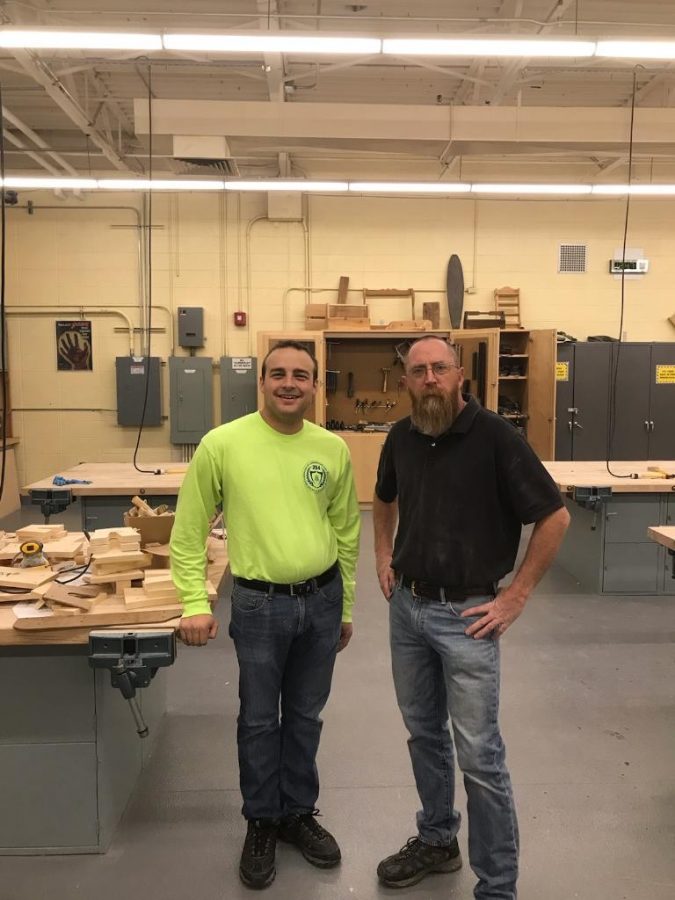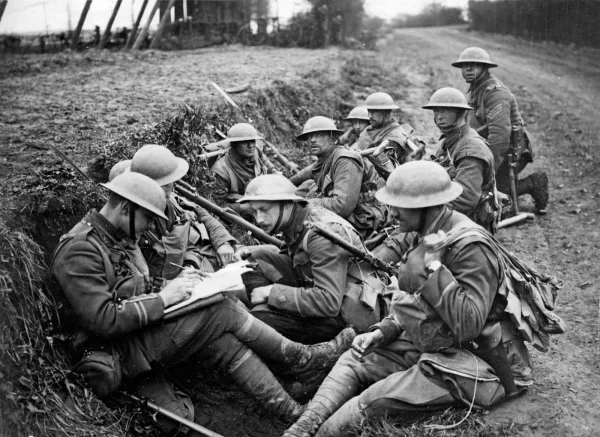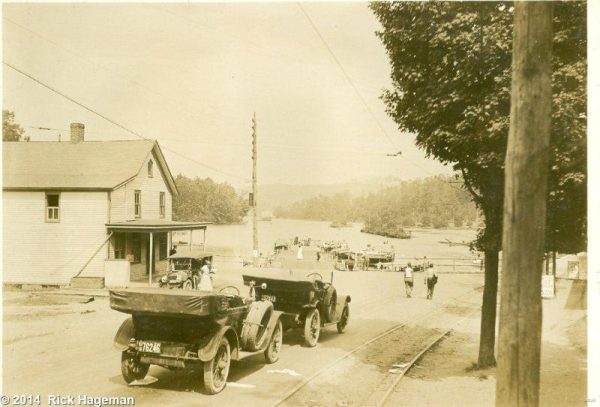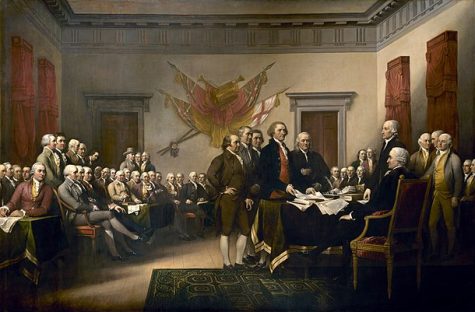New Course Alert: Wood Tech vs. SDF
November 25, 2019
Roxbury High School began offering a new course in the Industrial Arts and Technology department called Structural Design and Fabrication- taught by Mr. Caccavale. What a mouthful! The goal of this class was designed to teach kids technological skills they can apply in the future. Structural Design and Fabrication, also known as SDF is a class that applies woodworking towards large group projects, unlike individual projects that are created in Wood Tech. The SDF shop is located in H hall where the auto-shop class was over 15 years ago. Woodshop and SDF are both classes that can be beneficial to everyone in the future whether its fixing a broken shelf in their house or if woodworking or construction becomes their career. To better expand my understanding of this new program and the differences between Woodshop and SDF, I decided to interview Mr. Caccavale and Mr. Wood. Keep reading to find out more about the courses!
What do you think the biggest differences and similarities are between the Wood Tech classes and Structural Design and Fabrication?
Mr. Wood: “Obviously the biggest similarity would be the machinery and tools used to create a completed project. Students will learn how to use a variety of tools and machines safely and correctly. One of the big differences is that students in SDF will be focused on completing group projects for ‘clients’, as opposed to the woodworking classes, where the students will design and build individual projects for themselves.”
Mr. Caccavale: “Wood Tech focuses on teaching design through traditional material processes and fine woodworking to create furniture and cabinetry. SDF teaches students design principles through learning construction skills. Both courses focus on students being given constraints and learning about material properties and using this knowledge to make a tangible object. Students in SDF are exposed to many careers in architecture, construction, engineering, and skilled trades careers and a number of different skills that they can use when they become homeowners.”
How have the two of you worked together to develop two similar but separate programs?
Mr. Wood: “Mr. Caccavale is teaching a class that is open to seniors, so he has a good number of my current and past students in his class. In fact, I think he has at least a half dozen of my current Wood III/IV students in SDF. Because of this, we really need to collaborate quite a bit. Since his focus is primarily on structure type projects, like a boardwalk project for one of the other schools or a shed for ROXThon, he is taking the students in a direction that I don’t. My students still need to work on some of the fine woodworking skills when completing projects in my class while learning a different skill set in SDF. We talk frequently about the projects that he is working on and I see it as a way to add a dimension to my upper level classes that I otherwise would not have. I want the kids in my Wood II classes to consider taking SDF especially if a career in the trades is something they are thinking about.”
Mr. Caccavale: “Mr. Wood and I are very good friends and constantly work together to develop the vision for our department and how each of our courses work to fit into that vision. It’s interesting because I teach some Woods 1 courses, I am working to prepare students for their advanced level woodworking and in Woods 2, Mr. Wood covers topics to best prepare students for SDF. In reality we see many of the same students and have developed opportunities for students to learn what appeals to them and, in many cases, they can take SDF and woodworking.”
Mr. Caccavale’s Interview
What is the main purpose of Structural design and fabrication?
“Roxbury High School’s new Structural Design & Fabrication course lays a strong foundation for college and career success by teaching students fundamentals in the field. Students will learn how to work safely in a shop environment and develop skills that will give them a true competitive advantage in their careers. Students will have the opportunity to work both individually and in teams to design and build projects. Upon completion of the pathway, students can enter the Carpenters Apprenticeship Training program through the United Brotherhood of Carpenters. Through coursework and career guidance, students earn a competitive advantage in the job market. Whether students choose to go into a career related to the skilled trades, engineering, construction, or architecture, or just use these skills when they become homeowners, the experiences and lessons learned in SDF will stick with students for life.”
Since this is a new course this year, what are your expectations or plans for future years to come?
“We have a lot to be excited about in our new class. We have a partnership with the carpenter’s union, where students who take the course can join the union and shave a year off their apprenticeship. We are also working with Habitat for Humanity to find projects we can do to best help them. My goal is that, over the next few years, our class will grow to not only cover more content but also find more field trips and guest speakers. And to develop more projects to help our Roxbury community.”
What aspects of this course are not typically part of the woodworking curriculum?
“Mr. Wood teaches a very traditional and highly successful woodworking course sequence that is loved by many students past and present in our school community. It is important that the SDF course did not take away from his class, but rather build upon it. My class has very few individual projects but rather working together to build a larger scale structure. It’s a totally different experience for students when they are working together to design and build.”
As this is the first year that you have taught this class, how did you decide on the curriculum and projects you want to complete this year?
“It’s funny. When I was in high school there was a class on residential construction that I wanted to take so badly, but it never had enough interest to run while I was a student. Now almost 10 years later, I’m developing a curriculum for my dream class when I was a high schooler. Much of our curriculum has been what I wish I would have gotten to do in high school. I’m very appreciative of the carpenter’s union, and several other industry professionals who have helped us develop what the curriculum will look like this year.”
Students are able to get credit towards an internship by taking this class. What is that process like?
“Yes they are, we have signed an articulation agreement with the United Brotherhood of Carpenters where a student who has taken my class and is accepted to the union will get to shave a year off their apprenticeship.”
Are there any prerequisites to take this class and if so what are they?
“For next year students must take Wood Tech I, Engineering Drafting and Design I, or have my approval to register for SDF their senior year.”
Mr. Wood’s Interview:
As the Wood Tech teacher, what are your main goals to teach your students?
“The main goal for me is that the students learn how to use the equipment and tools correctly AND safely while learning how to solve problems and think independently. It is a common thing to hear many teachers talk about problem solving and project-based learning. The interesting thing is that the Industrial Arts and Technology department has been doing this for decades before it was a catch phrase.”
What do you think attracts students to Wood Tech the most?
“I think the fact that it is completely a hands-on class where students are able to express themselves through their work is one of the reasons students are attracted to the class. The courses in the woodworking program are unlike any other classes in many ways, but there is broad appeal across all types of students. I get a lot of artistic students who are looking for a different media to create in. I have had many honors students who express a desire to do something with their hands. I get a lot of kids who might want to work in a trades based environment like carpentry or auto mechanics and they have few options besides going to vo-tech.”
What do you think deters students from signing up for your class?
“One of the biggest things I have heard in the past is that freshmen had started to not bother signing up because the class is so popular, freshmen seldom get into the class. This year, Mr. Caccavale is teaching one Wood I section while I am teaching my normal three, so another 17 or 18 kids got into the class. This has allowed a lot of freshmen to get in. Another thing that I have heard is that female students are sometimes intimidated by the class, because it is typically thought of as a more “masculine class”. I think that is ridiculous, and I have spent a lot of time trying to get more young women to take the class. This year I believe there are 14 or 15 females in Wood Tech I which is a great number. Percentage wise, it is about 20% of the students in Wood Tech I. I would like to double that percentage in the next few years if I can, because the female population are just as capable of doing the same quality of work.”
Author’s Note: I took Wood Tech I last year and my class was mainly populated by boys but there were several other girls in the class, including myself. The class never felt too “masculine”. I never felt like I didn’t belong, but I was timid to take the class because that I knew very few girls took it. The large gap in the number of each gender taking a particular class is very unfortunate. Similarly, there are very few boys that take dance at RHS, but just like Wood Tech, the numbers are slowly growing.
Compared to a class with a state testing requirements, what do you base your curriculum on?
“There are state standards for Technology Education actually so the curriculum satisfies those standards. We also look to satisfy workplace readiness standards in the woodworking program. The curriculum has been rewritten once since I have been here as Mr. Shuttlesworth and I rewrote the Wood Tech I, II, and III curricula, and I just rewrote the Wood Tech IV curriculum this past summer. We looked at a number of other school’s curriculum so that we could find some ideas that we could add to our curricula while also looking for items that may have been outdated. Simply put, we looked at what we wanted the kids to be able to accomplish in each of the classes and then figured out how to get them there.”
How have you evolved the Wood Tech program since you began teaching at RHS?
“As stated earlier, one of the things I have done is get a lot more female students into the classes. My first year in Roxbury was the 2009-2010 school year, and there was one young woman in the program and none the next year. Since then, I have had no less than 6 or 7 in each year. I also tried to get a broader section of the student body interested in the class from the traditional blue collar student to the art and music students, the AP students and everyone in between. To accomplish this, I have changed a lot of the projects that we were creating in order to attract different groups of kids. I have had students make guitars and long boards for example. With the support of the art department, I have had student work showcased in a variety of art shows where the projects have frequently won ribbons. This helps attract different groups of students for one thing but it also helps showcase the work the students are doing and to have more students aware of what we do.”
How have you adjusted to having another shop in the school and how has working with another tech ed teacher benefitted your classes?
“Having another shop in the school is excellent from my vantage point. 25 years ago, there was wood shop, metal shop, auto shop, small engine repair, graphic arts, engineering design, architecture, and electronics classes all taught in Roxbury High School. Last year, we had wood shop and Engineering Design. Having a third set of class offerings makes the department stronger and more versatile. Having a newer teacher in the department gives us another viewpoint on the changing landscape of the Industrial Arts and Technology field. With Mr. C also teaching a Wood Tech I class, we are collaborating so that he and I are giving all of the Wood I students the skills and knowledge they will need as they move on to Wood II and Structural Design and Fabrication.”
It is clear that there are many similarities between Wood Tech and Structural Design and Fabrication but also a few significant differences. It is evident that a student could be enrolled in both classes and still get different skills and knowledge out of each. The classes work hand-in-hand and build off of each other to improve the program and the impact on students. One way to think of how these classes work together is that SDF teaches you how to build a house, but Wood Tech teaches you how to build the furniture.



























